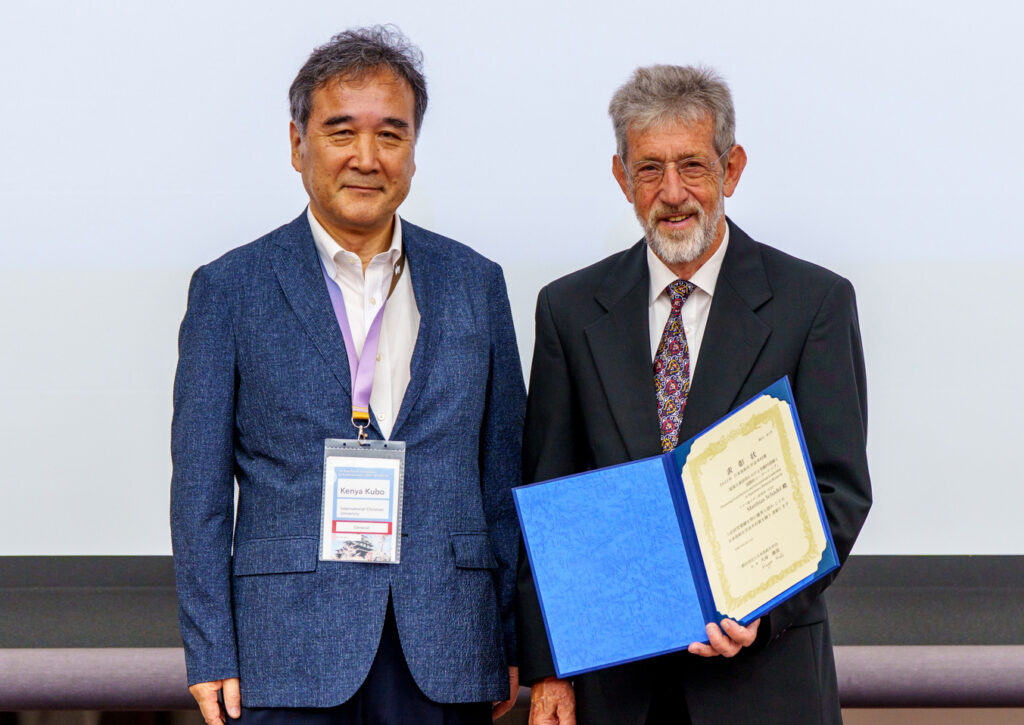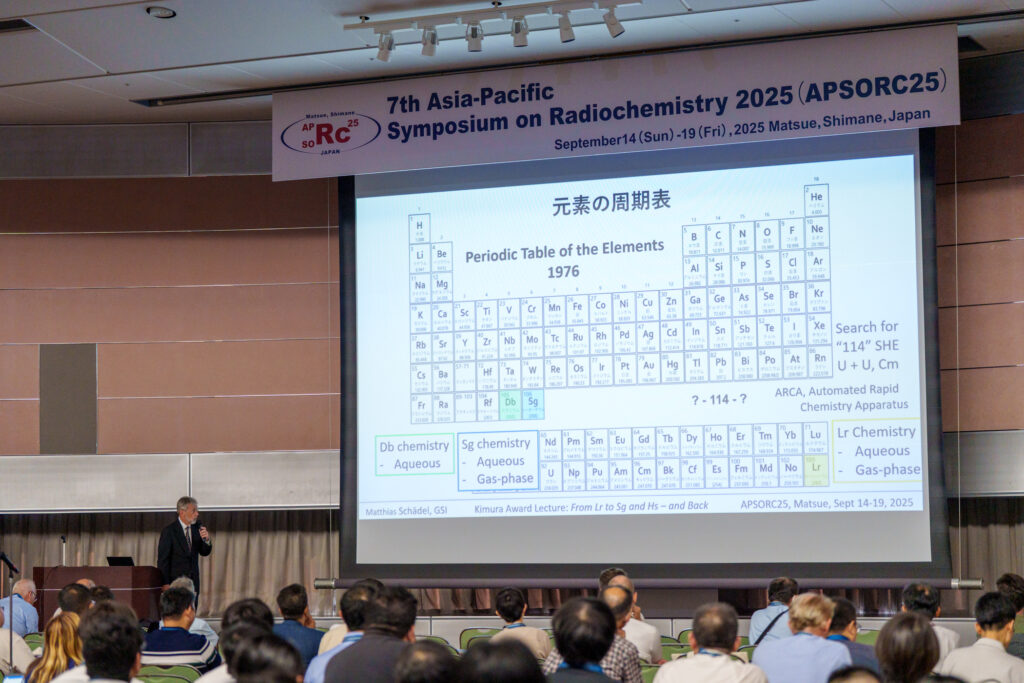The Japanese Kimura Award goes to Dr. Matthias Schädel, the former head of the research department for nuclear chemistry at GSI/FAIR, for his “outstanding and pioneering contributions to the advancement of radiochemistry.” Schädel is the first non-Japanese recipient of this honor. The award was presented at the APSORC 2025 (Asian-Pacific Symposium on Radiochemistry) held in Matsue, Japan, in September, in conjunction with a lecture by the award winner.
Award ceremony - Professor Kenya Kubo (l.), President of the Japan Society of Nuclear and Radiochemical Sciences, handed the Kimura Award to Dr. Matthias Schädel, the former head of the GSI/FAIR Nuclear Chemistry. Photo: Makoto Inagaki
During his time at GSI, Schädel established close cooperation with working groups in Japan in the mid-1990s, particularly with a group of the Japan Atomic Energy Agency (JAEA) in Tokai-mura, Japan. This collaboration has led to a long-standing, very fruitful exchange of personnel, instrumentation and ideas, including the participation of Japanese scientists in the first and so far only experiments on the chemistry of the element seaborgium in aqueous solutions at GSI and the participation of groups from GSI/FAIR and Mainz in developments and successful experiments in Japan.
Matthias Schädel studied chemistry at Justus Liebig University in Giessen and Johannes Gutenberg University Mainz (JGU). In 1979, he earned his doctorate with a thesis on the production cross sections of actinide isotopes in uranium reactions, which he conducted at GSI. From 1976 until his retirement in 2010 he worked as a scientist at GSI, since 1985 as the group leader and most recently as head of the research department for nuclear chemistry. His time at GSI was interrupted by guest stays at Lawrence Livermore National Laboratory (LLNL) and Lawrence Berkeley National Laboratory (LBNL) in the US, where he collaborated with Nobel Prize winner Professor Glenn T. Seaborg. He also lectured at Texas A&M University in the US and at JGU.
Dr. Matthias Schädel during the award lecture. Photo: Makoto Inagaki
After retiring from GSI/FAIR, Schädel took over as head of the Superheavy Element Chemistry Group at the Advanced Science Research Center (ASRC) of the JAEA, from 2010 to 2015. “A key success from this period was the measurement of the ionization potential of lawrencium (element 103), to which my research group also contributed, and which was honored on the cover of Nature,” reports Christoph E. Düllmann, professor at JGU and successor of Schädel as department head of the GSI/FAIR department for research on the chemistry of superheavy elements. “This work subsequently sparked an intense debate about the structure of the periodic table of elements.”
Dr. Matthias Schädel during his lecture. The slide shown in the photo also features an image of Prof. Kenjirō Kimura, the Japanese chemist after whom the award is named. Photo: Maiko Ikegami
This period also saw the highly acclaimed first synthesis and detection of a new chemical compound in superheavy elements, seaborgium hexacarbonyl, which was obtained at the Japanese research center RIKEN in an international collaboration led by Düllmann's group and including the JAEA group. The results were published in the journal Science.
The Kimura Award is the highest honor bestowed by the Japan Society of Nuclear and Radiochemical Sciences (JNRS). The award is named after chemist Professor Kenjiro Kimura, one of the pioneers of Japanese radiochemistry, who worked closely with Professor Yoshio Nishina on artificial elements and fission from the 1920s to the 1950s. The Kimura Award is presented for long-standing significant contributions with particularly excellent results in radiochemistry and related scientific fields. It has been awarded at varying intervals to only six recipients to date, including Kosuke Morita in 2019 for the discovery of element 113 at RIKEN.
Further information
• Press release of GSI (as pdf-file; German / English)
• Publications:
• Sato, T.K. et al.
Measurement of the first ionization potential of lawrencium (element 103)
Nature 520 (2015) 209-211
• see also:
A. Türler
Lawrencium bridges a knowledge gap
Nature 520 (2015) 166–167
• J. Even et al.
Synthesis and detection of a seaborgium carbonyl complex
Science 345 (2014) 1491
• see also:
W. Loveland
Superheavy carbonyls
Science 345 (2014) 1451-1452



